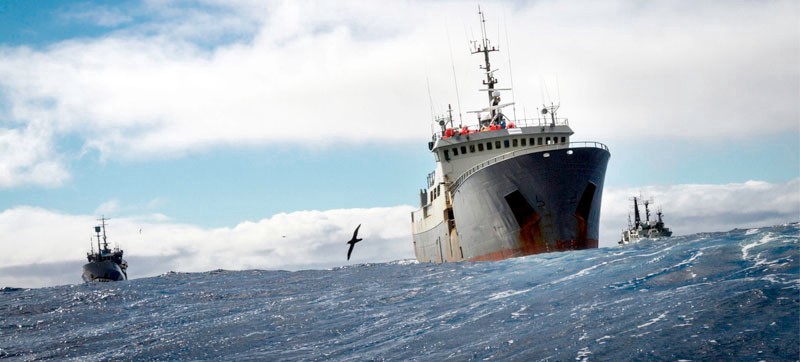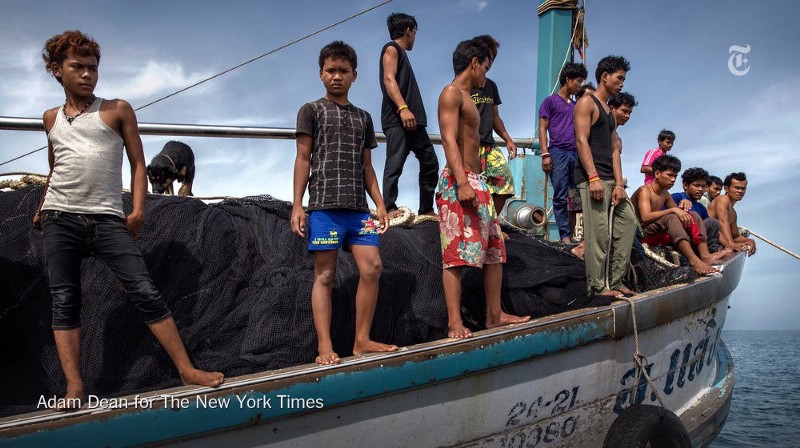“There are few remaining frontiers on our planet. But the perhaps the wildest, and least understood, are the world’s oceans: too big to police, and under no international authority, these immense regions of treacherous water play host to rampant criminality and exploitation.”
So reads the jacket copy for a remarkable new book, The Outlaw Ocean, by Ian Urbina, investigative reporter for the New York Times and W2O Advisor, to which we will devote the next four weeks to expose just some of the dark side of life at sea of which most of us are completely unaware.
In his Introduction, Urbina writes:
“About a hundred miles off the coast of Thailand, three dozen Cambodian boys and men worked barefoot all day and into the night on the deck of a purse seiner fishing ship. Fifteen-foot swells climbed the sides of the ship, clipping the crew below the knees. Ocean spray and fish innards made the floor skating-rink slippery. Seesawing erratically from the rough seas and gale winds, the deck was an obstacle course of jagged tackle, spinning winches, and tall stacks of five-hundred pound nets.”
“If they were not fishing, the crew sorted their catch and fixed their nets, which were prone to ripping. One boy, his shirt smudged with fish guts, proudly showed off his missing two fingers, severed by a net that had coiled around a spinning crank. Their hands, which virtually never fully dried, had open wounds, slit from fish scales and torn from the nets’ friction. The boys stitched closed the deeper cuts themselves. Infections were constant. Captains never lacked for amphetamines to help the crews work longer, but they rarely stocked antibiotics for infected wounds.”
“Virtually all of the crew had debt to clear, part of their indentured servitude, a ‘travel now, pay later’ labor system that requires working to pay off money they often had to borrow to sneak illegally into a new country… This was a brutal place.”
Urbina’s inquiry spanned forty months, 251,000 miles, 85 planes, forty cities, every continent, over 12,000 nautical miles across all five oceans and twenty other seas. “My goal was not only to report on the plight of sea slaves but also to bring to life the full cast of characters who roam the high seas. They included vigilante conservationists, wreck thieves, maritime mercenaries, defiant whalers, offshore repo men, sea-bound abortionists, clandestine oil dumpers, elusive poachers, abandoned seafarers, and cast-adrift stowaways.” In the end, the success of Urbina’s narrative is “to bear witness to a world rarely seen.”
“At times,” he writes, “the reporting process was so zigzagging it felt less like journalism than an attention deficit disorder. But the more I traveled, the more one story led to another — none of them neat or tidy, none of them split clearly between right and wrong. Like the oceans themselves, the stories that emerged were too sprawling to force into a single, straight-line narrative.”
“For all the adventure, though, the most important thing I saw from ships all around the world…was an ocean woefully under-protected and the mayhem and misery often faced by those who work those waters.”
When we think of the ocean, our first thought is of the beauty and the creatures there. That perception, in and of itself , is enough to fight for, what Jacques Cousteau famously characterized as “protecting what we love.” A larger view amplifies our understanding to perceive the ocean as an integrated global technical, financial, and political system that informs how we live our lives on land, and sea, looking backward, and looking forward, to suggests ways to incorporate this meaning into strategies for mitigating environmental impact, and inventing new alternative systems and processes as applied action through ocean conservation tools.
But Urbina shows us something else: the social ocean, a place on which real people are immersed in a human search for livelihood and freedom, brutally confronted and compromised by avarice, servitude, invisible corporate and governmental malfeasance, and collective indifference to equity and human rights. His is a courageous and important opening to the reality that lies behind the beauty and fecundity of marine resources, that must be an integral part of what we must know about our ocean world and of what we must do about it for the benefit of all mankind.
- - -




